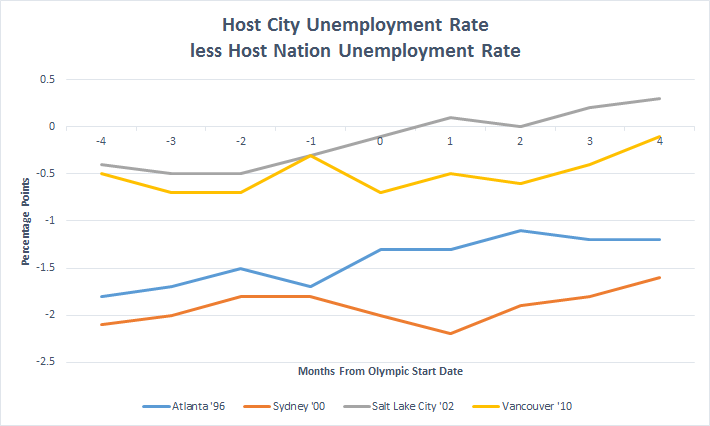Olympic Infrastructure as Keynesian Stimulus
Since the first international Olympic Games in 1896, the Olympics has served as an opportunity for host cities to boost their economies. Employment surges are largely attributed to sudden increases in jobs needed for preparations, staffing, and construction. As Los Angeles looks to the 2028 Olympics, The Lowe Institute has used data from past Olympics to estimate the expected benefits to the local labor market.

To do so, we gathered monthly data for city-wide unemployment rates for as many host cities as we could. We then took the difference between this local unemployment rate and the national unemployment rate so as to eliminate nation-wide events and focus only on the effect the Olympics was having on the host city. Having high frequency (monthly) data was important for us to be able to isolate the effect of the Olympics from other events which may be happening in the same year. Unfortunately, high frequency city unemployment rates are hard to come by, limiting us to just four cities: Atlanta ’96, Sydney ’00, Salt Lake City ’02, and Vancouver ’10.
Ideally, we would look at the decline in unemployment that occurs due to the onset of construction, marketing, and staffing. But the relevant projects start at widely different and unobservable time periods prior to the actual event so it would be difficult to find the proper date at which to compare local and national unemployment. By contrast, many if not most of these jobs end in a narrow window around the Olympics as construction finishes just prior to the event and staffing finishes just after the event. Thus we track these unemployment rates during an eight month window centered on the start of the one-month Olympic Games.
Each of the host cities starts the period with a negative value indicating that local unemployment is below national unemployment. The positive trend common to all four cities represents the host cities’ faster growing unemployment rates relative to their respective countries. This growth is consistent with the new jobs in construction and staffing (i.e. transportation, ticketing, operations, accommodations, and hospitality) ending once the Olympics are over. Our regression analysis yields that the average change in the city-specific unemployment rate is 0.528 percentage points over this 8-month period. We interpret this as the approximate measure of the tail-end decline in unemployment due to Olympic construction, staffing, and preparation. We can take this is a rough estimate of the boom to employment during preparation, though we do not know how long these jobs last.
Despite these observed booms, the number of bids to host an Olympics have steadily decreased over the last twenty years. Eleven cities competed to host the 2004 games whereas only two submitted bids to host the 2024 Olympics. This drop in bids can be explained by the trend of host cities typically incurring accounting losses due to the same factors which generated the preceding boom. The temporary jobs created by the Olympics cost money and the promises made for extravagant new infrastructure are not always recouped in broadcast rights, ticket sales, and merchandising. Moreover, the new infrastructure is not always effectively repurposed for post-Olympics use. The abandoned athletes’ village from the Rio 2016 games is a prime example, costing over $700 million only to be 93% vacant just a year later.
Los Angeles holds one key advantage setting itself apart from other recent host cities: an ability to rely on pre-existing structures rather than construct new ones. Suitable event sites spread out across a wide area of Los Angeles County, such as the LA Coliseum built for the 1932 Olympics, a future NFL stadium in Inglewood, and planned expansions to UCLA student housing will allow the city to avoid the long-term costs of large-scale construction projects. This abundance of already established venues should control costs for 2028 in a similar fashion to the 1984 Los Angeles Olympics, the only Olympic Games to turn a profit in modern history. However, fewer new buildings also means fewer temporary construction jobs. Because of its rich existing infrastructure, Los Angeles may avoid both the gain and the pain experienced by prior Olympic host cities.

